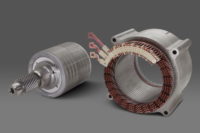The COVID-19 crisis has upset life on college campuses around the United States. But, that hasn’t stopped next-generation engineers from innovating.
A good example is a low-cost ventilator that was recently developed by engineering students at the University of Minnesota. The Coventor is a compact, desktop-sized device that is relatively inexpensive to manufacture.
Ventilators are used in a clinical setting to assist patients with increasing their blood oxygen levels. Traditionally, they help patients with pneumonia and acute respiratory distress. But, during the coronavirus pandemic, ventilators have become a critical treatment device.
A team of University of Minnesota engineers adapted their initial prototype using an assortment of available machinery components. They created a custom slider-crank mechanism that allows medical staff to control how oxygen is delivered to patients.
“Because of its ease, simplicity and cost, we believe this concept can be scaled in many different designs,” says Aaron Tucker, a lab supervisor at the Earl E. Bakken Medical Devices Center and a graduate student in the College for Science and Engineering.
The U.S. Food and Drug Administration has already authorized the production, use and distribution of the device to health care systems.
“Support from design partner and manufacturer Boston Scientific, and input from Medtronic, have been helpful through the FDA process,” claims Tucker.
According to Tucker, the Coventor’s specifications have been made open source so other manufacturers globally can begin their regulatory and production processes.
“This allows patients who wouldn’t otherwise have the opportunity to survive, to survive,” notes Tucker. “The Coventor gives people a chance, and that is what this is all about. Making the ventilator as fast as possible, pushing it to people everywhere.”
Meanwhile, engineers at the Georgia Institute of Technology turned their attention to developing do-it-yourself personal protective equipment that can be assembled where it’s needed from components that are locally available.
Georgia Tech faculty and students worked on multiple face shield designs, talking with experts at the Global Center for Medical Innovation, in addition to local institutions such as Children’s Healthcare of Atlanta, Emory Healthcare and Piedmont Atlanta Hospital. The result was two different designs intended for specific uses in hospitals, where face shields protect healthcare professionals from splashes and help extend the life of soft respirators intended to filter out virus particles.
“The team has worked hard to identify material suppliers and define simple, scalable solutions to meet this challenge,” says Sam Graham, chairman of the Woodruff School of Mechanical Engineering. “We are fortunate to have partners ready to team up with us to help address some of the shortfalls in medical equipment that hospitals are experiencing.”
To scale up fabrication beyond the Georgia Tech campus, the engineers focused on simple designs that could be shared with and produced by individuals with access to a makerspace, in addition to manufacturers with injection molding capabilities. They plan to make the designs available to anyone with laser cutting or 3D printing capabilities.
“[Our] mechanical engineers are working to modify open-source face shield designs so they can be manufactured in high volumes for the rapid response environment that COVID-19 requires,” Graham points out. “[They have] modified these designs using a range of product and process optimization methods, including removing certain features and standardizing tool use.
“By working on cross-functional and cross-disciplinary teams, and directly involving healthcare practitioners and high-volume manufacturers, we will be able to respond to this effort at the scale and speed required,” claims Graham.
“The best thing we can do is share that information broadly to try to come up with solutions that use parts that can be sourced locally,” Graham points out. “Simple solutions using motors that people can get anywhere, structures that can be 3D-printed and materials that can be hand-cut with saws may get us through this.”
For instance, Georgia Tech engineers are working with Cranfield University in the UK to create a makeshift ventilator based on a bag-valve-mask, which is also known as an Ambu bag—a handheld mechanical resuscitation device.
“Through a system of laser-cut gears and other components, the preliminary concept would use a simple 3-volt motor to compress the bag and push air into the lungs of a critically ill patient,” says Leon Williams, head of the Centre for Competitive Creative Design at Cranfield University. “Among the challenges is extending the lifetime of the bags, which are not designed for long-term use.”
Georgia Tech engineers are also developing new types of filtration systems that can protect healthcare workers from the coronavirus. This requires soft face masks that remove virus particles from the air. Because the tiny particles are hundreds of nanometers in diameter, that protection requires high-efficiency filtration materials that until recently were mostly manufactured in China.
“The filters are not being produced at the rates that are needed, so we have been thinking about what we can put together that approximates an N95 filter that’s needed to protect healthcare workers,” notes Ryan Lively, an associate professor in the School of Chemical and Biomolecular Engineering at Georgia Tech. “We need to make something that can be produced out of homemade goods, then verify that it can do the filtering needed.”
Lively has been experimenting with alternatives, such as high-efficiency filtration materials manufactured for HVAC systems that could be sewn inside a fabric pouch. “[Some] filtration materials not as good as N95 are still effective at increasing rejection of the virus particles,” he explains.
“We have estimated that we can produce 700 masks per week using the pilot line that we have for research and repurposing it for cranking out hydrophobic fiber media,” adds Lively. “That won’t solve the problem, but it will help meet a very critical need.”






